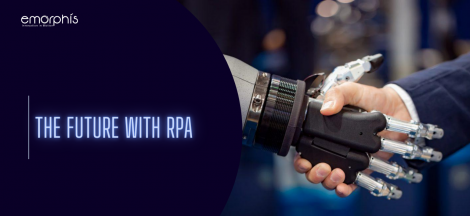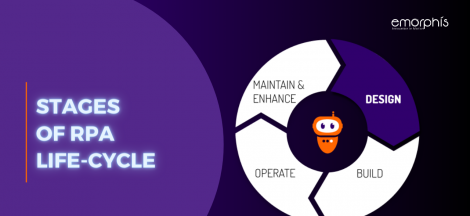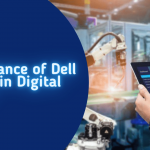Introduction
Robotic Process Automation or RPA is a technological trend that is getting immense prominence by organizations across the globe to invest in it. Why? To increase their operational throughput, and reduce their operational cost!
Nevertheless, a report from the Deloitte survey has pointed to the fact that companies starting their journey with Robotic Process Automation implementation have been struck due to the resurfacing of IT issues, unrealistic expectations, and complexity associated with the process.
So, there is a need to maximize the impact of enterprise RPA by having a revolutionary shift in the mindset by following a transformation instead of an experimentation approach. In the given article, the major focus will be on identifying readiness in Robotic Process Automation software with various planning stages to clearly understand the successful Robotic Process Automation implementation.
By becoming aware of the passage from each stage of RPA implementation, an organization can reap rich benefits from the initiative taken by the given automation system.
Do you want to kick-start your move by taking the first initiative? Then identify some point of contact for the management to drive it smoothly via implementation phases:
1. Proof of Concept (POC) Phase
In the given phase, a program manager works in collaboration with the functional and technical team to identify and find out factors before initiating the RPA software automation in an organization. It starts with some set of questions such as:
- Which RPA software tools must be used for effective automation?
- What should be the infrastructure? Whether it will be on-premise or cloud-based?
- Does the implementation of RPA will be either through an in-house team or through external vendors (outsourcing)?
- Will the deployment of the product be compatible with supporting the RPA automation tool?
- Does there is any governance model to check the proper implementation of the program?
The main objective of the POC stage is to find out the best RPA tools as well as vendors for effective implementation that must be as per the respective RPA implementation policies and procedures.
2. Preliminary Phase
Experts should start with any project cautiously. Yes, because it will help the organizations to identify the opportunities and implement the given feedback early in the Robotic Process Automation life-cycle. Furthermore, its development life-cycle helps in maintaining the quality and sustainability of the given solutions resulting in RPA consulting services.
Furthermore, RPA implementation requires verification in one of its environments before sending it to the production phase. Besides, there is also a bot monitoring procedure that is utilized for performing quality checks on the bot before sending it to production.
It is the responsibility of the program manager to closely monitor the progress and rectify any issue that is affecting its performance. This is so because the preliminary phase is a critical stage that offers great benefits to the RPA program.
3. BOT Monitoring Readiness Phase
It is one of the most crucial phases as it ensures that the design reviews are in place, and there is a building-up of enough mechanism for effecting monitoring of the given software bot. In the present time, organizations are in an ever-expanding mode, thanks to mergers and acquisitions.
So, the addition of software bots of Robotic Process Automation helps in the quick turn-around of the operational needs of any firm. It can happen only if there is high scalability of the bots and adherence to the non-negotiable design goals during RPA implementation.
Apart from this, Robotic Process Automation service providers must come with a dedicated team that has expertise in business processes and technology to utilize them before the commencement of the given project. Thus, there should be a detailed plan and readiness to offer great comfort to business management before embarking on their journey towards RPA automation.
4. Steady Phase
Business management always anticipates the fact that there is a generation of enthusiasm and push from the preliminary stage to embrace the RPA journey well. By now, it has become prudent that Robotic Process Automation governance is fully operational and should give more priority to cater to business urgency.
One such criterion should be the cost-benefit analysis mechanism that will help the organization to be well-prepared for the projects currently in the pipeline. After the initial phases, there is great control over the delivery and implementation of the products by the organization.
What’s more, there is a significant reduction of the infrastructure challenges. Besides, services such as managing change management mechanisms successfully and monitoring bots in the production phase have been accomplished in the given phase most appropriately.
So, the above-given four phases are much-needed fill-up in embarking on a journey towards a perfect Robotic Process Automation implementation. But before concluding, it is necessary to understand some important facts to make a successful implementation of RPA software in your enterprise. so let us check out some of them.
Successful Implementation of RPA Software In Your Enterprise
a. Picking Up the Right Procedure during Project Preparation
It is a simple yet essential approach that requires a thorough assessment of working in various departments across numerous firms. It starts right from the preliminary phase of the Robotic Process Automation implementation. In this phase, management tries to figure out which process will undergo automation to align business objectives with available technology adoption.
Furthermore, it also takes some key considerations such as:
- Setting up the project timeline
- The volume of transactions done with no human involvement
- The requirement of resources and labor for the given task
- Identification of the roles and responsibilities of workers involved in it
- Check the capability of the procedure for offering error-free outcomes
- Checking its cost-effectiveness with technical complexity
By keeping the above-given aspect in mind, it will become easy to address the potential risks and barriers associated with the given task before the commencement of the project that is going to be automated.
b. Proper Management of Employees
Not just changes in how to operate the machine, Robotic Process Automation also makes momentous changes in the management of the people. Most of the employees are skeptical of the automation system as they believe it is a system to destroy their livelihood.
Hence, it becomes important to convince the employees to adjust well to the new automation system. Otherwise, the communication gap between the management and employees will destroy the efficacy of the RPA automation system.
It is natural for the employees to be uneasy while accompanying their work with the automation system. Nevertheless, it becomes important to have an open and honest discussion with them to address the issue diplomatically related to automation.
c. Selection of the Knowledgeable Vendor
To achieve a better result, it becomes prudent to get access to the right vendor to stay abreast of the wide landscape of the given robotic process automation software. In the given section, some questions arise in the mind of the management. How much to engage with them to enhance the coverage of deployment? How to make the personal data of the customers safe?
So, selecting one of the best Robotic Process Automation service providers is a hectic task. But if you have been able to find one; then be ready to get customized solutions to meet your needs and expectations steadfastly. Nevertheless before selecting them, first ask them about the cost and time require deploying the workforce. Besides, also evaluate whether are they capable of meeting a few criteria such as:
- Expertise in error management
- Wide experience in the given domain
- Capable of adapting to changing technologies
- Can also perform an audit if need rise
So, following all the given criteria, assure yourself to get access to the services of the best working person who has a great understanding and is proficient in dealing with the complexity associated with RPA.
d. Implementation of the ‘Big’ Idea
Before proceeding to the actual execution of the bot, it becomes mandatory to follow a structured approach carefully that highlights your overall business strategy precisely. Initially, give the task to your team and provide the guiding principles to implement automation in a casual approach.
Moreover, you can have the liberty to choose the best Robotic Process Automation service providers who have domain expertise and the technical competence to undertake the successful implementation of the given automation tool.
Moving to the next level, it is essential to design a process map to highlight a specific area where automation is needed. Furthermore, documenting the given map will help you to make your RPA bots play an important role.
e. Leave Some Room for Performance Measurement
It is no use of the RPA implementation if you cannot see the benefits it offers to the company after its tremendous growth. To measure it effectively, identify some key performance indicators that include:
- Measuring the efficiency of the deployment of Robotic Process Automation for processes related to the back-office
- Assuming the decrease and increase in the employees’ productivity
- Analyzing Robotic Process Automation compliance reports that prescribe how better way bots adhere to rules and regulations
So, these are all the facts that help an organization to get successful RPA consulting services through its seamless implementation.
Wrapping Up
Robotic Process Automation has great potential to enhance the efficiency rate of any given organization. However, if not taken proper planning, it can lead to failure. So, the crucial phase of RPA implementation is to follow the above-given stages with close monitoring to iron out flaws. Therefore, follow these steps and reap benefits to get quick results towards automation.
Further, find more details on Web 3.0







